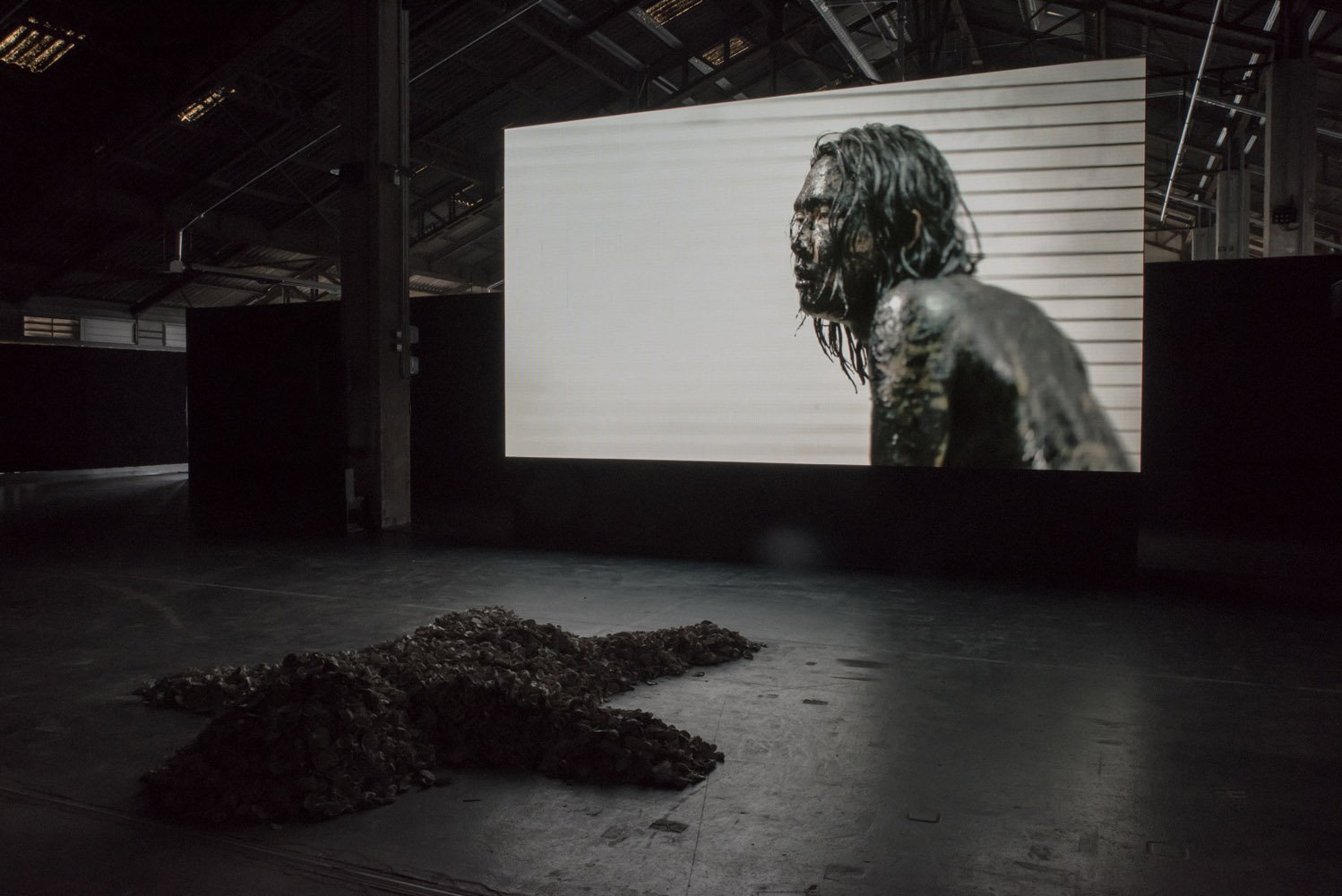Korakrit Arunanondchai : with History IV
2018, J1, Marseille.
Cur. Emmanuelle Luciani & Charlotte Cosson.
Artists : Korakrit Arunanondchai.
FR/ Les vidéos de Korakrit Arunanondchai semblent poser les questions : « Qui porte la mémoire du monde ? » et « Qui la recueillera lorsque nous ne serons plus ? ». Poésies du temps qui passe et s’imprime comme sur un jean blanchi, et de l’acuité de la haute définition qui remplace petit à petit la vision humaine, s’entremêlent dans ces contes contemporains où coexistent plusieurs civilisations, espèces et futurs sur une même planète blessée.
Korakrit Arunanondchai revient à la terre en présentant une sédimentation de terreau, coquillages, algues et peinture latex aux allures de fuel. C’est à partir de ce sol que l’artiste pense demain : l’uberman sera-t-il androgyne ou couplé avec la machine ? Y-aura-t-il coexistence ou remplacement de l’humanité par une civilisation de rats géants ou de drones ? Afin d’appréhender différentes issues à ces questions, Korakrit Arunanondchai prend littéralement de la hauteur, en adoptant le point de vue plongeant d’un drone nommé Chantri. A la manière d’un philosophe antique qui prônerait une tentative de sortie du langage afin de pouvoir le comprendre, l’artiste tente une échappée hors de la pensée horizontale en matérialisant une vision non humaine.
Pourtant, il adresse au drone ces questionnements inconnus du monde de la machine : « Crois-tu en quelque chose, Chantri ? », «Réussirons-nous à ne faire qu’un avec toi et à nous dématérialiser dans le flux de l’Esprit ? ». Contrairement aux idées reçues d’un transhumanisme dénué de spiritualité, Korakrit Arunanondchai rappelle le caractère ontologiquement messianique de la recherche d’une humanité améliorée. De plus, l’Internet des objets, en offrant une intelligence – voire une âme – aux choses, ne rejoint-il pas les croyances animistes millénaires ? Le sol ici produit participe de cette même réflexion sur l’ADN ou la charge historique de tout item. À l’image de Mozart qui, en mourant, est devenu musique, le roi de Thaïlande, à son décès, a muté via les croyances. La terre qu’il aurait foulée de ses pieds est dorénavant sacrée. La fossilisation du sol est à l’image de la sédimentation historique : nous sommes poussière et redeviendrons poussière. Chaque chose contient à la fois la cellule originelle et le germe de la vie nouvelle.
Korakrit Arunanondchai réfléchit ainsi au retour du spirituel via la machine et à un transhumanisme respectueux de la Terre. Il en revient à une des étymologies du terme « religion » : ce qui relie. Au-delà des paradoxes, il emprunte une voie du milieu et fait voler en éclat les antagonismes écologie/robotique, mort/amour, nature/culture et réconcilie par là même les philosophies orientale et nietzschéenne se situant toutes deux par-delà le bien et le mal.
EN/ Korakrit Arunanondchai’s videos appear to ask questions: Who carries the memory of the world? And who will recover it once we are no longer here? The poetry of passing time leaves its marks, just as faded jeans bear traces of their past, and these poetic marks are woven together with the high-definition vividness that is gradually replacing human vision to create contemporary fairy tales where multiple civilisations, species, and futures coexist on the same wounded planet.
Korakrit Arunanondchai returns to earth by presenting sedimentary layers of loam, shells, seaweed, and latex paint that glimmers of fuel. The artist considers the future from the ground up: will the ultimate incarnation of humankind turn out to be androgynous or bionic? Will humanity be replaced by a civilisation of giant rats or drones, or will there be some form of coexistence?
In order to grasp some of the different possible outcomes of these inquiries, Korakrit Arunanondchai decides to literally look down upon them by adopting the sweeping viewpoint of a drone named Chantri. In the manner of an ancient philosopher that extols the notion of leaving language behind to better understand it, here the artist attempts to escape horizontal thinking by adopting a non-human perspective.
Yet he asks the drone questions that are unheard of in the world of machines: “Do you have any beliefs, Chantri?”
or “Will we manage to become one with you and dematerialise into the flow of the Great Spirit?” Contrary to popular misconceptions of a transhumanism stripped of spirituality, Korakrit Arunanondchai accentuates the ontologically messianic nature of the quest for an improved human. What’s more, does not the Internet of Things, which gives intelligence—maybe even a soul— to ordinary objects, echo of the beliefs of millennial animists? The ground produced here extends these thoughts into the realm of DNA, where every item is charged with history. In the image of Mozart, who was transformed into music upon his death, the King of Thailand mutated into his very faith upon his death as the earth upon which he walked became sacred. The fossilisation of dust is the epitome of historic sedimentation: we are dust and to dust we shall return. Everything contains both the original cell and the seed of new life.
In this manner, Korakrit Arunanondchai considers a reappearance of spirituality via machines and a transhumanism that is respectful of the Earth. He seizes upon one of the origins of the term “religion”: the Latin word religare, meaning “to bind together”. Surpassing paradoxes, he takes a middle road to shatter antagonistic juxtapositions between ecology/robotics, death/love, or nature/culture and uses this same path to reconcile Eastern and Nietzschean philosophies by appreciating that their realms reach far beyond mere notions of good and evil.





